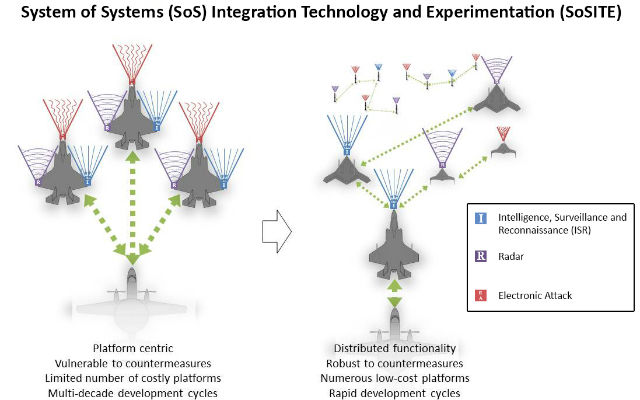In an effort to avoid new airborne technology becoming obsolescent as a result of expensive and slow integration, the US Defense Advanced Research Projects Agency has launched a project to explore the quicker integration of new systems with existing technology.
The System of Systems Integration Technology and Experimentation (SoSITE) project will “develop and demonstrate concepts for maintaining air superiority via novel SoS architectures”, and will combine aircraft, weapons, sensors and command and control systems with existing manned and unmanned aircraft.
“As advanced technologies have become more readily available to adversaries on commercial markets, the nation’s focus on ever more complex weapons systems has become not just a strength but also a weakness,” DARPA explains.
“Effective as they are, US military systems today are often too expensive to procure in the quantities needed, and may take so long to develop that the electronic components they contain are obsolete by the time they become operational.”
Noting that it can be timely and expensive to field or upgrade airborne systems, Nils Sandell, director of DARPA’s Strategic Technology Office (STO), says that it has in turn become difficult for military technology to keep pace with “rapid advances in commercial technology”, so a system-of-systems approach could help overcome stovepipe development.

DARPA
Concept development contracts have been awarded to Boeing, General Dynamics, Lockheed Martin and Northrop Grumman, which are developing and analysing SoS architecture technology and flight experimentation plans.
In addition, Apogee Research, BAE Systems and Rockwell Collins are developing tools and technologies to enhance current open-system architecture approaches.
SoSITE will take advantage of advances in miniaturisation, increased capability and decreased cost of electronics, new algorithms and software technology, and advanced materials for creating “innovative” unmanned platforms, DARPA adds.
“Cost savings may be realised by separating payload from platforms, thereby allowing defence planners greater flexibility in choosing cost-versus-capability trade-offs for each,” it adds.
DARPA uses smartphone technology as an example of how hardware can be simply modernised and updated without altering it in anyway.
“You don’t need to buy a new smartphone every time an app comes out with a new capability,” John Shaw, SoSITE programme manager in STO, says. “SoSITE’s technology integration focus area will build the ‘under-the-hood’ verification and cyber-defence capabilities so airborne platforms can host interchangeable ‘app’ functions.”
Source: FlightGlobal.com






















